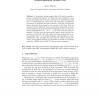89
Voted
DM
2008
15 years 13 days ago
2008
Motivated by a new point of view to study occurrences of consecutive patterns in permutations, we introduce the notion of uniquely k-determined permutations. We give two criteria f...
106
Voted
EJC
2010
15 years 13 days ago
2010
Abstract. Motivated by juggling sequences and bubble sort, we examine permutations on the set {1, 2, . . . , n} with d descents and maximum drop size k. We give explicit formulas f...
103
Voted
IOPADS
1996
15 years 1 months ago
1996
The ability to perform permutations of large data sets in place reduces the amount of necessary available disk storage. The simplest way to perform a permutation often is to read ...
NIPS
2008
15 years 1 months ago
2008
Motivated by applications like elections, web-page ranking, revenue maximization etc., we consider the question of inferring popular rankings using constrained data. More specific...
112
Voted
FUN
2010
Springer
15 years 3 months ago
2010
Springer
Conventional wisdom suggests that O(k)-time is required to reverse a substring of length k. To reduce this time complexity, a simple and unorthodox data structure is introduced. A ...
88
Voted
ITP
2010
15 years 4 months ago
2010
Pitts et al introduced a beautiful theory about names and binding based on the notions of permutation and support. The engineering challenge is to smoothly adapt this theory to a t...
86
Voted
ICCD
2000
IEEE
15 years 4 months ago
2000
IEEE
This paper proposes a new way of efficiently doing arbitrary ¢ -bit permutations in programmable processors modeled on the theory of omega and flip networks. The new omflip ins...
ICALP
2004
Springer
15 years 5 months ago
2004
Springer
We study the random composition of a small family of O(n3 ) simple permutations on {0, 1}n . Specifically we ask what is the number of compositions needed to achieve a permutatio...
123
click to vote
CPM
2004
Springer
15 years 5 months ago
2004
Springer
A popular approach in comparative genomics is to locate groups or clusters of orthologous genes in multiple genomes and to postulate functional association between the genes contai...
100
Voted
WABI
2005
Springer
15 years 5 months ago
2005
Springer
—We propose new algorithms for computing pairwise rearrangement scenarios that conserve the combinatorial structure of genomes. More precisely, we investigate the problem of sort...





